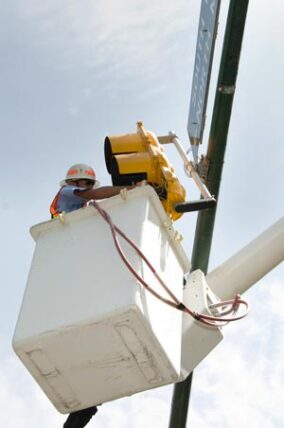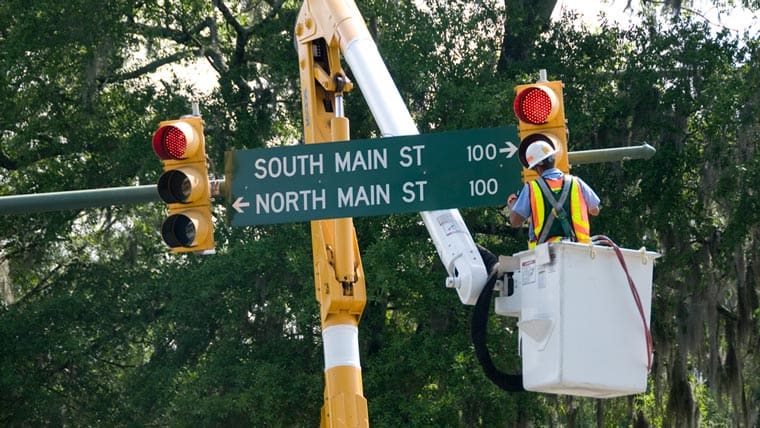Some of the most intelligent and capable people I’ve met are signal maintainers. These unsung heroes are often overlooked when it comes to handing out accolades. Traffic signals look so simple—all they do is change from green to yellow to red, right? But in reality, signal maintenance requires experience and skill in traffic operations, electrical systems (including field installation), utility coordination (both above and below ground), network communications, and knowledge of multiple software programs for signal equipment. In addition, signal maintainers must work in and near the roadway, around electric systems, often in the air, at all times of the day, and in all weather conditions. Signal maintainers must be able to identify and repair malfunctioning signals in limited time, often without assistance, with minimal expense and tools. This job is vital to maintaining safe and efficient roadways.
When it comes to developing a successful signal program, it is important to foster respect and communication between the maintenance staff and engineering (managers) staff. As engineers, spending time with signal maintenance staff will improve the knowledge of both parties and allow issues to be addressed more effectively. Communication is especially important during emergencies, as that is when agencies ask the most of field staff.
Signal Maintenance Types
General Maintenance includes repairing and replacing signal equipment, addressing signals in flash, repairing detection, replacing LED modules.
Preventative Maintenance includes reviewing signals on a cyclical basis, such as yearly, to replace conflict monitors and cabinet filters, clean around the cabinet, possibly treat the cabinet for pest infestations, review and maintain that detection is operational and signal heads are in good shape and within height requirements, and check that pedestrian phases are operational. Preventative maintenance forms are typically filled out and any identified work issues are repaired immediately or scheduled.
Emergency Maintenance involves repairing signals that have been damaged by a catastrophic event, such as a lightning strike, vehicle collision, high winds or falling tree limbs. Repairs may include replacing entire cabinets with all necessary equipment, replacing poles and span wire, or replacing signal heads.
Typical Signal Maintenance Duties
- Signal Repair includes signal heads (replacing signal modules/visors/backplates) and cabinets (troubleshooting issues such as resetting conflict monitors, addressing wiring issues, replacing detector cards, and replacing controllers, flasher, and conflict monitors). This duty includes being ‘on call’ on nights and weekends in case emergency repairs are needed. Performing annual preventative maintenance reviews is recommended to catch problems before they occur and to check that signals are operating as designed. This becomes critically important as signal infrastructure begins to age, as it can identify remedial issues requiring full rebuild. These may include severely deteriorated poles and spans, crumbling hand holes, or obsolete equipment and inability to obtain replacement parts. Signal Programming involves testing the cabinet, programming the controller for signal timings, checking the signal coordination settings, programming the conflict monitor, setting up signals, and updating information in the central database.
- Signal Equipment involves becoming proficient with installation methods including software, replacement parts, attachment hardware, connection cables, warranties, and testing equipment.
- Network Communications includes coordinating with network staff, installing/testing/repairing fiber, and setting up and installing radios, switches, and cell modems.
- Utility Coordination includes setting up electric service, coordinating for attachment agreements, and calling for locates.
- Vehicles/tool maintenance involves checking that service vehicles have standard equipment and tools for making repairs, and that tools are operational. This also includes performing safety reviews for vehicles, including buckets are operational and equipped with safety harnesses and tethers.
- Traffic Control involves providing staff with training and access to items such as crash cushions, arrow boards, and signs/cones, along with the manpower to set up, operate, and break down work zones.
- Detection maintenance includes maintaining, repairing, and replacing detection systems for high priority roadways as soon as possible. The enemy to inductive loops is any type of resurfacing, utility work or driveway installation. In addition, poor pavement conditions often result in damage to inductive loops. Video detection systems may require repositioning and periodic cleaning of lens.
- Signal Construction involves installing conduit and splice boxes; installing electric cable using messenger/span wire; installing foundations for cabinets and steel poles; saw-cutting and installing loop wire for inductive vehicle detection; installing wood poles and guy cables; and installing pedestrian poles, buttons, and pedestrian heads.
- Signal Inspection involves attending preconstruction conferences and subsequently on site to inspect any signal construction. In most cases, signal maintainers are the most qualified personnel to perform an inspection for a signal installation.
- Other duties may include maintaining parking meters, controls for irrigation systems, automated gates, lighting systems (interstate, bridge, roundabouts or buildings), and drawbridge systems. Many signal shops are tasked with any job that may require an electrician or lighting specialist.
Additional Considerations

Staffing. It is desirable to have one signal technician per every 40 signals. Many signal shops don’t have enough staff to perform all the duties listed above. On-call signal services contracts can be set up to provide additional staff to perform work as needed. These contracts can be very helpful during emergency operations or for more involved signal work, such as signal rebuilds. In addition, it’s very helpful if signal maintainers can obtain assistance from roadway maintainers for setting up traffic control during signal maintenance activities. It’s important to provide career planning for signal staff to provide qualified people to take on leadership roles when people move or retire. Many signal shops divide duties, and cross training may not typically occur. Therefore, it is important to provide training opportunities, including cross training. It’s also important to provide incentives to keep and recruit qualified staff.
Budget. As discussed in an earlier blog on signal inventory, once you know how many signals/flashers you maintain, as well as the type and age of equipment and the condition of each signal, you can calculate what your maintenance and capital expense budget should be. A target amount for signal maintenance budgets is 3% of signal installation costs. For example, an $80K signal = annual maintenance allocation of $2400. Therefore, 300 signals at $80K each, 3% maintenance = $720K/year for maintenance activities. Additional funds are needed to maintain signal system communications and network devices, as well as advanced systems detection and software. Funding for capital projects may be part of a signal maintenance budget or may be a separate program. Establish a life cycle for signals to estimate the annual rebuild funding required for signal upgrades. For example, 300 signals with a 15-year life cycle at $80K per replacement = $1.6M per year, rebuilding 20 signals per year. The cost to install and maintain signals will vary based on regional costs, complexity of the signal and type of signal support poles.
Training. International Municipal Signal Association (IMSA) provides a certification platform for signal maintenance certification. Equipment vendors will also provide training on setup and troubleshooting their equipment. Local power companies may also provide training for electrical safety. In addition, many signal shops provide on-the-job training for new employees. Other beneficial training includes signal software training (vendor-provided), work zone training, signal construction training (based on standard drawings/ specifications), fiber installation training including splicing techniques and testing, and network communications training for wireless broadband radios, ethernet switches, and cell modems.
Shop Inventory. Signal shops should keep spare equipment available for emergency and regular maintenance activities. Signal equipment is valuable and having a central location that is secured, protected from weather, and monitored by personnel or cameras can provide equipment when needed. In addition, there should be a check in/check out process for signal equipment to keep signal inventories maintained and updated.
Our transportation team at Mead & Hunt has several signal maintenance contracts and can provide guidance or assistance in providing signal maintenance services.



